Guide to chainsaw chains

This is the second part of our guide to the chainsaw cutting system, which is the assembly consisting of the guide bar and chain. In the first part we covered chainsaw guide bars, how to choose the right one and why it’s important, explaining how a chainsaw guide bar is made, as well as discussing cutting length, the types of guide bar available on the market, when it is necessary to replace the bar, how to choose one carefully and why it’s important.
In this article we focus on the chain, which is literally the cutting edge of a chainsaw. In the previous article we mentioned that the guide bar’s cutting length, in addition to the chainsaw’s power rating, gives a general idea of what the chainsaw can do. But the machine’s actual performance essentially depends on the type of chain and its efficiency. So, let's see how to keep your saw chain in perfect working order.
Types of chainsaw chain
Chainsaw chains consist of three types of link, each having different shapes and functions:
- Drive links: pulled by the clutch bell, the drive links fit into the bar groove and guide the chain's movement.
- Teeth: also known as cutters, these shave chips off the timber just like a wood planer.
- Joining links (tie straps) with and without integrated rivets: these connect the drive links to the teeth.
To reduce the risk of kickback, chains may have links and teeth with specially shaped safety profiles, which ensure good penetration of the chain into the wood with less bouncing and vibration.
The teeth have an L-shaped cutting edge, which removes the wood in chips like a planer, and a depth gauge (raker) to limit the depth of cut. There are different types of teeth; the most common being:
- Chisel: has an L-shaped cutting edge with a square top corner
- Semi-chisel ("planer"): with a rounded top corner
What is the best chain for a chainsaw? Chains with chisel teeth attack wood with more force and therefore cut faster, but are trickier to sharpen. Chainsaw chains with semi-chisel teeth are less likely to kickback, get dull less quickly and are easier to sharpen, so they are best option if you don't have much experience using a chainsaw.
Based on the sequence and number of cutters (teeth), chainsaw chains can be divided into the following types:
- Standard: this is the best type because it has the maximum possible number of teeth (each joining link is followed by a tooth, with the teeth alternately attached on the right or left side of the chain).
- Skip: 2 joining links separate the teeth, which are alternately attached on the right and left side of the chain.
- Semi-skip: alternates between 1 and 2 joining links separating each tooth.
But which of these types of chain works best? Standard chains guarantee excellent cutting performance because they have the maximum number of teeth possible, compared with semi-skip and skip chains. However, skip and semi-skip chains work well with underpowered chainsaws or very long guide bars because there is less resistance when cutting, and they also take less time to sharpen. We explain how to sharpen chains in one of the next paragraphs.
How to choose the best chainsaw chain
Have you noticed the numbers printed on the chain links? They indicate the pitch and thickness (gauge) of the chain. For example, the number "21" on OREGON chains indicates a pitch of .325" and a gauge of .050" (1.5 mm). When buying a new chain for your chainsaw you need to know its basic specifications:
- Chain type: tooth shape (chisel, semi-chisel etc.), safety features, sequence (standard, semi-skip or skip chain).
- Pitch (in inches): the distance between any three consecutive rivets, divided by two.
- Gauge (in inches or millimetres): the thickness of the drive links.
- Number of drive links that make up the chain.
Where can you find this information? Some chainsaw guide bars have it printed on the tail end (near the body). Otherwise, see the user and maintenance manual for your chainsaw. If you have an Efco chainsaw, you can find out which is the best chain for your machine by asking one of our dealership technicians for advice.
In our article on chainsaw guide bars, we mentioned that it is important to adhere to the manufacturer's recommendations, and the same goes for the chain. Only fit guide bars and chains that are approved for your model of chainsaw. Otherwise, you will void the chainsaw’s warranty and the manufacturer will be relieved from any liability.
Referring back to the examples in our guide to chainsaw guide bars, the MT 3500 S compact chainsaw is equipped as standard with a 35 or 41 cm long guide bar with fixed nose sprocket, which must be used in combination with chains having a .3/8" pitch and 1.3 mm gauge, low-vibration chamfered chisel cutters, rounded depth gauge and safety joining links, all in standard sequence. The 35 cm guide bar requires a chain with 53 drive links, compared with 57 drive links for the 41 cm bar.
By contrast, the Efco MT 6510 professional chainsaw is fitted as standard with a 46 or 51 cm guide bar with replaceable nose sprocket and a chain with .3/8” pitch, but a 1.5 mm gauge, semi-chisel cutters and impact-resistant drive links in standard sequence. The number of chain drive links is 68 and 72 respectively, depending on the guide bar length.
Finally, the MT 5200 medium power chainsaw is fitted as standard with a 41, 46 or 51 cm guide bar with fixed nose sprocket. In this case the chain gauge is also 1.5 mm but the pitch is .325". In addition, the chain has low-vibration micro-chisel cutters, safety cutters and drive links, in standard sequence. Depending on the guide bar length, the chain has 66, 72 or 78 drive links respectively.
Chain maintenance is important because a well-kept chain extends the life of the guide bar and the clutch bell (the device that makes the chain move). Chain maintenance includes all the tasks that we have summarised in the following paragraphs:
- Cleaning
- Sharpening
- Tensioning
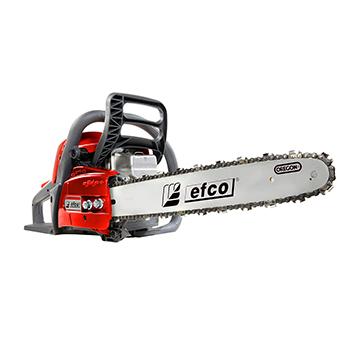
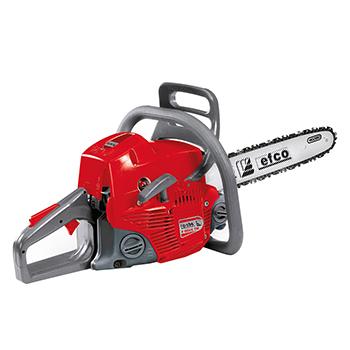
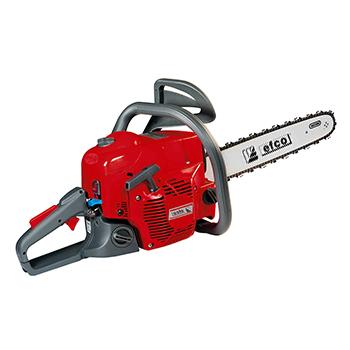
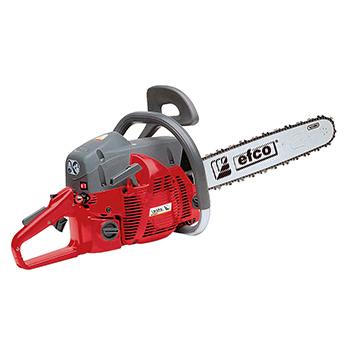
Chainsaw chain oil
Before discussing maintenance of the chain itself, let’s look at another job that is essential for keeping it in perfect working order: lubrication. Lubricating oil protects the chain and guide bar against seizure and wear by reducing friction between the guide bar groove and the chain links, ensuring smooth operation and a longer service life.
So, remember to top up your chainsaw’s chain oil reservoir.
When the chain is moving, the oil pump distributes lubricating oil from the reservoir to the groove on the upper side of the bar through a dedicated hole. The pump regulates the oil supply (flow rate) automatically, or you can regulate the flow manually using an adjuster screw to calibrate the lubrication of the chain according to the type of oil, the guide bar length, the wood you are cutting and the ambient temperature. The MT 5200 medium power chainsaw and MT 6510 professional chainsaw models that we mentioned earlier have an oil pump that is both automatic and adjustable and delivers no flow at the minimum setting, whereas the MT 3500 S compact chainsaw is automatic and also delivers no flow at minimum setting.
Which oil should you use for your chainsaw chain? Only use high-quality oil formulated for chains (not engine oil, recycled oil or waste oil) such as Efco CHAIN LUBE guide bar and chain protector, which is available in 1 L and 5 L cans, as well as 20 L and 200 L drums.
Cleaning the chainsaw chain
It's time to clean the chain on your chainsaw! Always wear chain-resistant gloves when handling it, and take this opportunity to check for damaged links and blunted teeth.
To clean your chain thoroughly, follow this procedure:
- Take off the chain guard and remove as much sawdust, dust and oil as you can using compressed air or a brush with stiff bristles.
- Disassemble the bar, remove the chain and pass a scraper along the groove and through the lubrication hole.
- You can degrease the chain and guide bar using petrol or, even better, a specially formulated product such as Efco multipurpose concentrated degreasing detergent.
- Don’t forget to clean the breather and filter on the chain oil reservoir.
But the chain isn’t the only part of a chainsaw that you have to keep clean: there are also the spark plug, carburettor, air filter and muffler. Worried about leaving something out? Read this article, where we summarise all the steps for cleaning your chainsaw to keep it in perfect condition.
Sharpening the chainsaw chain
A sharp chain is essential if you want a clean cut. For optimal cutting performance and comfortable operation with few vibrations, all the teeth must be the same length and sharpened to the same angle.
Your chainsaw chain needs sharpening when:
- You have to push the guide bar into the wood to cut it, instead of lowering effortlessly.
- You can't cut straight: the chainsaw wanders, i.e. cuts sideways.
- The chainsaw throws out sawdust rather than large chips of wood.
- The chainsaw vibrates and bounces while cutting.
- Cutting generates smoke, even though the chain is properly lubricated and tensioned.
How do I sharpen my chainsaw?
Firstly make the following preparations:
- Thoroughly clean the chain (read the paragraph headed "Cleaning the chainsaw chain").
- Tension the chain so that it is tauter than normal.
- Identify the most worn tooth: this is the "reference tooth", which you can compare against all the other teeth after sharpening it.
- Secure the guide bar in a vice and run the chain until the reference tooth is in the sharpening zone.
- Engage the chain brake.
At this point, take a round file of suitable diameter with respect to your chain (follow the manufacturer's instructions, in principle the diameter should be from 4 to 5.5 mm):
- Start with the reference tooth and then proceed to all the other teeth, filing first on one side of the bar and then on the other side.
- File each tooth outwards, in other words, only making strokes away from your body.
- Follow the manufacturer's instructions to ensure the correct angle between file and guide (usually 90°) and sharpening angle (most commonly 30°).
- If necessary, also file the depth gauge with a flat file to restore the height difference between the L-shaped cutting edge and the depth gauge: refer to the manufacturer's instructions for the correct value (usually .025" or 0.64 mm).
Efco also offer round bars and flat files for sharpening your chainsaw chain. Once you have finished sharpening all the teeth, you then need to tension the chain. Let's see how.
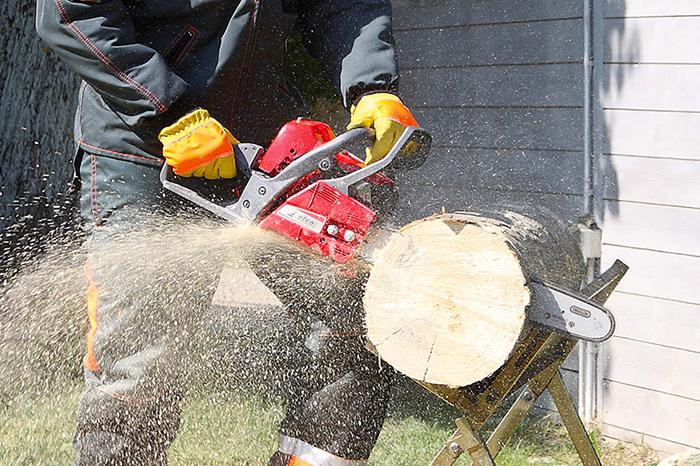
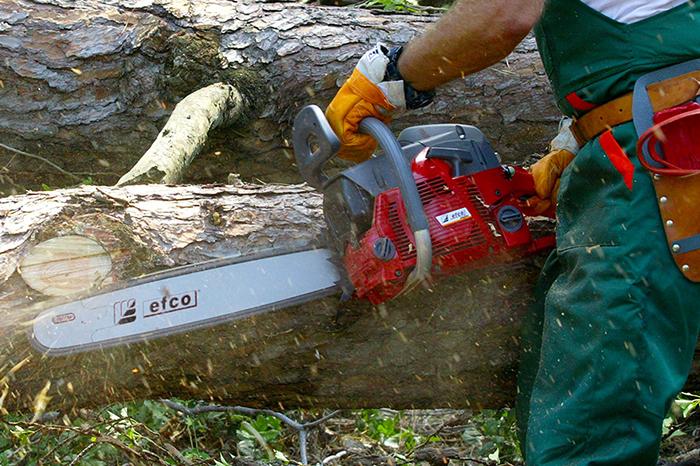
Tensioning the chainsaw chain
The saw chain must not sag on the underside of the guide bar. Why is it important that your chain is correctly tensioned? Because the chain’s tension affects the efficiency and durability of the guide bar/chain assembly. A saw chain that is too tight causes the guide bar to wear out faster, whereas a loose chain may jump out of the guide bar groove.
It is normal for the chain to gradually loosen as you work, so periodically check and adjust the tension. To test it, release the chain brake and, still wearing chain-resistant gloves, run the chain along the groove by hand. A properly tensioned chain will be fully seated in the groove and rise a few millimetres when pulled upwards, revealing 3-4 full drive links (or 4-5 in the case of a carving guide bar).
This adjustment must be made with the engine switched off and the chain cold: a chain that is hot when tensioned may shrink as it cools down, becoming excessively taut.
Follow these steps to adjust the tension of your chainsaw’s chain using the tensioner:
- Loosen the fastening nuts on the chainsaw’s guide bar.
- Raise the nose of the guide bar.
- Adjust the chain so that it is fully seated in the groove of the guide bar: the tension needs to be higher for bars with a sprocket tip.
- Keeping the tip raised, tighten the guide bar locking nuts.
- Check that the chain runs smoothly when the chain brake is released, and that 3-4 drive links are visible when the chain is pulled upwards, as described above.



